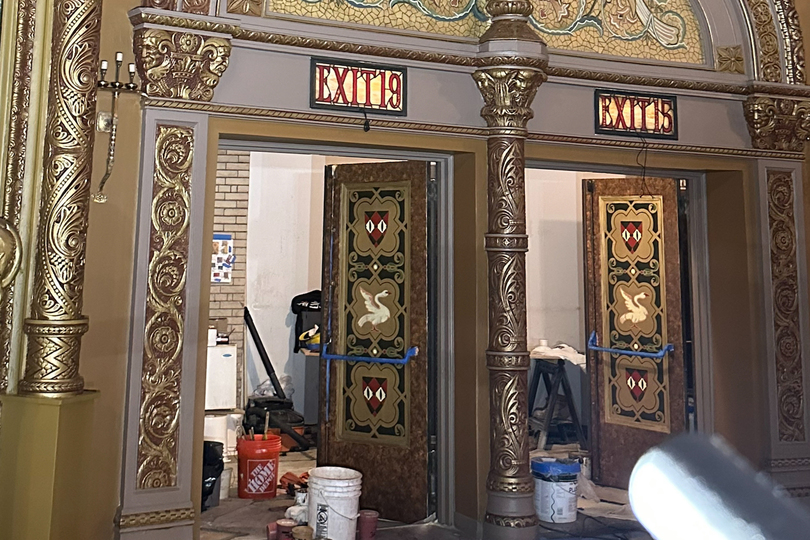Landmark Theatre reinforces spot as cultural staple, restores 1920s grandeur

As the Landmark Theatre approaches its 100th anniversary, restoration is bringing the Syracuse culture hub back to its 1928 roots. Over the last three months, 22 John Tiedemann Incorporated employees have worked long hours to complete the project. Courtesy of Ray Tiedemann
Get the latest Syracuse news delivered right to your inbox.
Subscribe to our newsletter here.
In 1928, Syracuse’s newest movie palace raised its curtain for the first time, complete with Tiffany-style chandeliers and a pipe organ. The theater thrived throughout the Great Depression and World War II. But by the mid-1970s, it seemed like the curtain was coming down for the final time as the theater faced demolition.
But the city wasn’t ready to let its theater go. A nonprofit committee rallied support and raised $32,000 to save the theater, while the state stepped in to provide the rest of the funds, ensuring that today’s audiences would still be able to take one of the 2,800 seats in the Landmark Theatre.
“If you’re a Syracuse native, you’re familiar with the Landmark in one way or the other,” said Mike Intaglietta, the theater’s executive director.
As the Landmark approaches its 100th anniversary in a few years, it once again faces an era of change. The theater is undergoing a comprehensive restoration to bring it back to its original 1920s splendor. A third of the $1.5 million necessary for the first phase of the restoration came from a grant facilitated by Syracuse Assemblyman William Magarelli, with private donors and the Landmark equity funding the rest, Intaglietta said.
The first, most difficult phase of the project — restoring the theater’s proscenium arch, walls and ceiling stretching to the back balcony — is already complete. The rest of the work, including the orchestra area and the back of the balcony, should be complete by summer 2027, Intaglietta said.
John Tiedemann Incorporated, a company dedicated only to historic restorations, took on the job. The theater hadn’t seen any renovation since the 1970s, said Ray Tiedemann, the company’s owner. After 50 years of accumulated wear, tear, layers of paint and cigarette smoke, the original colors of the theater’s ornate murals and stencilling were no longer visible.
Once the Tiedemann team arrived on the scene, they realized that in order to restore the theater, the paint would need to be chemically removed to access the original plaster. This step added another layer of difficulty to the process.
The hardest part? The theater had to be show-ready in only three months for the North American Broadway tour of “Hamilton” in September.
“It’s very stressful for us to have our theater torn apart,” Intaglietta said. “They had to remove 10 or 11 rows of seating. We had scaffolding everywhere. We had to remove all the lights. It was very nerve-wracking.”
Victoria Bingham, a color-matching specialist, said when she first walked into the theater and saw the scale of the task, she wasn’t convinced the restoration would be possible in the three-month time frame. Bingham came out of “semi-retirement” to work on the project with her husband and son, also artists, in matching the original 1928 colors.
For the Tiedemann construction team, the theater was a worthy challenge. Tiedemann is from upstate New York, and said he always enjoys working in the area. The company’s resume includes other Syracuse staples like St. Matthew’s Church and the Marriott Syracuse Downtown. They are no stranger to working on 100-year-old buildings like the Landmark.
“It’s normal for us,” Tiedemann said. “It’s not normal for most, but normal for us.”

The Landmark Theatre’s ornate murals and stenciling had been obscured by half a century of wear, tear, paint and cigarette smoke. These details have been restored in the first phase of its recent historical renovation. Courtesy of Ray Tiedemann
To access the ceiling and arch, the team needed to install large amounts of scaffolding. Installing and removing the scaffolding added two weeks at the beginning and end of the process, Tiedemann said, limiting the actual working time to only around 11 weeks.
Once work began, it began in earnest. Twenty-two people worked long hours to complete the restoration, with 12 staying on the scaffolding stripping paint for eight weeks straight. Bingham’s color-matching skills were ready for the challenge.
Bingham takes pride in her ability to look at a color and understand exactly what needs to be added to white paint to replicate it. Though nobody ever taught her the skill, she said color theory comes naturally to her. Even with Bingham’s propensity for color-matching, the Landmark was a challenge.
“Theater lights throw color,” Bingham said. “So what you’re seeing there and what you’re seeing at your work table in good lighting is 100 different things. It could take 20 trial and errors putting color up before I finally nailed it.”
After the careful work was complete, areas on the ceiling that had previously been plastered and repaired became indistinguishable, Bingham said. The theater was transported back in time.
Despite the cosmetic transformation, things at the Landmark are much different than they were a century ago. Instead of showing movies, the theater now brings in Broadway shows, a result of industry pressure in the early 1950s following the Supreme Court’s decision in United States v. Paramount Pictures, Inc.
This decision limited movie multiplex monopolies, eliminating the need for 2,800-seat theaters, like the Landmark, as more smaller theaters began to open. The Landmark then transitioned into a concert venue until the 2010s. The theater hosted movie marathons during the slow season, but by the 2010s, the biggest crowd one of those events drew was 100 people. The model didn’t make economic sense, Intaglietta said.
As it did in the past, the Landmark adapted. The theater expanded its stage and built out its basement to accommodate touring companies, making the Landmark a viable location for Broadway tours.
The plan worked. According to Intaglietta, last year was the Landmark’s busiest on record, with 163,000 people attending around 85 events. Next year, Intaglietta hopes to host closer to 100 events. He wants to keep the business nimble and resilient enough to accommodate a growing population in Syracuse following investments from Micron.
The Landmark is an essential draw for the city of Syracuse, Bingham said.
“It helps to have universities and hospitals,” she said. “We have them both. It helps to have sports and entertainment. We have that. We have the New York State Fair. We’ve got the Dome, all the different schools have their games. But what about culture?”
Bingham said if the Landmark had succumbed to the changing industry forces in the 1950s or 1970s, its absence would’ve left a “gaping hole” in the cultural fabric of the city. The Landmark’s role, she said, makes her even prouder to have been part of restoring it.
As a local to the Syracuse area, Intaglietta understands the importance of the Landmark. It seems to run in his family. He remembers visiting for an animated movie marathon with his older sister. His mother used to work as an usher at the theater, while his father preferred to sneak in through the side doors to catch a showing.
Though Landmark has been supported by the Syracuse community since the 1970s, the outlook is different now that the goal isn’t saving the theater. It doesn’t need saving.
Now, Intaglietta hopes to make the space as beautiful and effective as it can be, so that future generations have a theater they can be proud of.
“What I always like to say is that my grandparents’ generation built the theater,” Intaglietta said. “My parents’ generation saved it and preserved it. My generation is responsible for bringing it up to its full potential, so I can pass it on to my daughter’s generation.”






